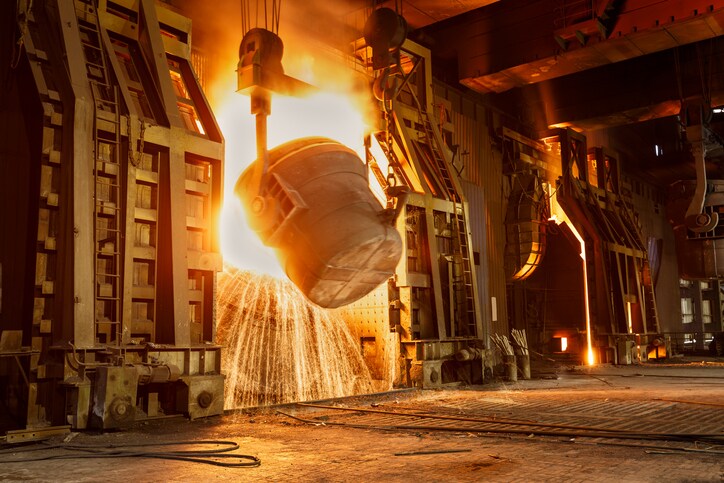 Sinter is the primary feed material for making iron in a blast furnace. During the iron ore sintering process in iron and steel manufacturing, sinter is created by mixing iron ore concentrate with several additives such as limestone and silica to control the chemistry and then igniting it at 1200°C in a continuous belt-fed furnace. The production of high-quality sinter is crucial for assuring consistent, stable furnace productivity with a low consumption of reductants. Sinter quality begins with the proper selection and mixing of the raw materials. Inhomogeneous raw mix can affect permeability and cause an increase in fuel consumption and sinter return fines.
Sinter is the primary feed material for making iron in a blast furnace. During the iron ore sintering process in iron and steel manufacturing, sinter is created by mixing iron ore concentrate with several additives such as limestone and silica to control the chemistry and then igniting it at 1200°C in a continuous belt-fed furnace. The production of high-quality sinter is crucial for assuring consistent, stable furnace productivity with a low consumption of reductants. Sinter quality begins with the proper selection and mixing of the raw materials. Inhomogeneous raw mix can affect permeability and cause an increase in fuel consumption and sinter return fines.
According to the U.S. Environmental Protection Agency, the sintering process converts fine-sized raw materials, including iron ore, coke breeze, limestone, mill scale, and flue dust, into an agglomerated product, sinter, of suitable size for charging into the blast furnace. It outlines the process as follows:
The raw materials are sometimes mixed with water to provide a cohesive matrix, and then placed on a continuous, travelling grate called the sinter strand. A burner hood, at the beginning of the sinter strand ignites the coke in the mixture, after which the combustion is self-supporting and it provides sufficient heat, 1300 to 1480°C (2400 to 2700°F), to cause surface melting and agglomeration of the mix. On the underside of the sinter strand is a series of windboxes that draw combusted air down through the material bed into a common duct, leading to a gas cleaning device. The fused sinter is discharged at the end of the sinter strand, where it is crushed and screened. Undersize sinter is recycled to the mixing mill and back to the strand. The remaining sinter product is cooled in open air or in a circular cooler with water sprays or mechanical fans. The cooled sinter is crushed and screened for a final time, then the fines are recycled, and the product is sent to be charged to the blast furnaces. Generally, 2.3 Mg (2.5 tons) of raw materials, including water and fuel, are required to produce 0.9 Mg (1 ton) of product sinter.
Sinter feed composition control is important because the various sinter feed materials are not perfectly characterized and their chemical makeup varies within a batch and between batches. Therefore the raw feed material chemistry changes and the additives feed rates should be adjusted to smooth out these variations in the sinter strand feed chemistry.
Throughout the process, analysis technology is utilized to measure and control sintering process fluctuations, inhomogeneous mixtures, and other parameters that affect productivity, physical and metallurgical quality, and raw material consumption and costs. Most commonly the sinter product is sampled after cooling and crushing. This requires a well-designed sampling system consistent with the Theory Of Sampling. Lab analysis of the samples is used to determine sinter quality and this information is used to adjust the proportion of feed materials making up the sinter feed to achieve predetermined KPIs such as basicity. Due to process residence times and circuit dynamics the lab information can be delayed many hours. Compositing of samples and frequency of sampling are used to manage the workload to the lab but because they are low frequency tend to smooth out and under-report the true variability of the sinter feed. This slow feedback to control actions leaves room for further reduction in sinter feed KPI variability and optimization of use of raw material in blending.
Online Elemental Analyzers provide high frequency online elemental analysis of an entire raw material process stream using Prompt Gamma Neutron Activation Analysis (PGNAA) and Pulsed Fast Thermal Neutron Activation (PFTNA). By measuring the entire sinter feed conveyor belt load in real time sampling errors and control information measuring lag are nearly eliminated.
PGNAA and PFTNA are non-contact, non-destructive analytical techniques used in online analysis systems to determine the elemental composition of bulk raw materials. Both of these techniques are known collectively as neutron activation analysis and function by bombarding materials with neutrons.
The neutrons interact with elements in the materials, which then emit secondary, prompt gamma rays that can be measured. Similar to X-ray fluorescence (XRF), each element emits a characteristic energy signature as it returns to a stable state. (Visit this page to learn more about PGNAA and PFTNA technology.)
PGNAA analyzers are situated directly on the conveyor belt and penetrate the entire raw material cross-section, providing minute-by-minute, uniform measurement of the entire material stream, not just a the surface or a sub-sample sample. This is the reason PGNAA analyzers are valuable tools for optimizing sinter feed basicity. Surface analysis technologies such as XRF, X-ray diffraction (XRD), and other spectral analysis technologies measure limited depths and surface areas that may can never be representative of the entire volume of material on the belt. With PGNAA, sample errors are reduced, and the high-frequency of analysis helps reduce variability in material quality.
Additional Resources:
- PGNAA and PFTNA Technology website page
- PGNAA Detection Limit Guidelines
- Application of on-line elemental analysis for control of sinter feed basicity
- Sinter FAQs
- Theory Of Sampling paper from the Royal Society of Chemistry






Leave a Reply